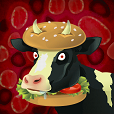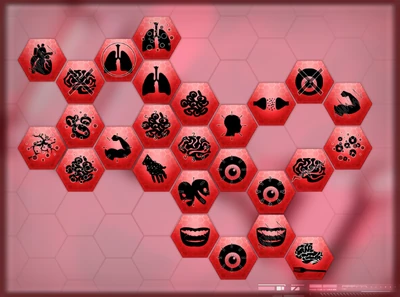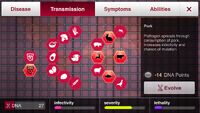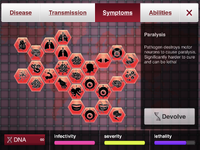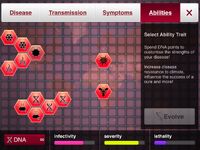m (Formatting) |
Tag: Visual edit |
||
| Line 225: | Line 225: | ||
|Pathogen becomes harder to analyze in the lab. Decreases future research speed |
|Pathogen becomes harder to analyze in the lab. Decreases future research speed |
||
|- |
|- |
||
| − | |[[Genetic Hardening 2]] |
+ | |[[Genetic Hardening 2]] |
|The pathogen does not reproduce in lab conditions. Decreases future research speed |
|The pathogen does not reproduce in lab conditions. Decreases future research speed |
||
|- |
|- |
||
Revision as of 14:40, 26 September 2020
The Mad Cow Disease, known in-game as 'v2.CJD', is a plague type and scenario in the Mutation 1.15 update. It is one of the three scenarios that are included in the update, along with Flight Club and Where Is Everyone?. The update also emphasized this scenario in the name of "Mega Moo-Tation"
Transmissions
| Avocado | Pathogen spreads through consumption of avocado. Increases infectivity, especially in rich countries |
| Beef | Pathogen spreads through consumption of beef. Increases infectivity and chance of mutation. Popular in rich countries |
| Broccoli | Pathogen spreads through consumption of broccoli. Slightly increases infectivity |
| Dairy | Pathogen spreads through consumption of dairy products, such as milk and cheese. Increases infectivity and chance of mutation |
| Fish | Pathogen spreads through consumption of ocean travelling and farm raised fish stocks. Increases infectivity and chance of mutation |
| Frozen Storage Resilience | Cell-adapted shifts in protein structure lets pathogen thrive over long food supply chains. Increases ship and plane transmission |
| Hermetic Storage Resilience | Minor protein alterations raise chance of pathogen remaining active via long haul food suply chains. Increases ship and plane transmission |
| Insect (Mad Cow Disease) | Pathogen spreads through (accidental) consumption of insects. Increases infectivity and chance of mutation. Especially effective in arid climates |
| Lamb | Pathogen spreads through consumption of lamb and mutton. Increases infectivity and chance of mutation |
| Maize | Pathogen spreads through consumption of corn products. Increases infectivity, especially in poor countries |
| Mango | Pathogen spreads through consumption of mangos. Increases infectivity, especially in hot climates |
| Pork | Pathogen spreads through consumption of pork. Increases infectivity and chance of mutation |
| Potato | Pathogen spreads through consumption of potatoes. Increases infectivity, especially in cold climates |
| Poultry | Pathogen spreads through consumption of poultry. Increases infectivity and chance of mutation |
| Preservative Storage Resilience | Significant amino acid variances trigger rapid pathogen development when refrigerated. Increases ship and plane transmission |
| Rabbit | Pathogen spreads through consumption of rabbit. Increases infectivity and chance of mutation. Especially effective in rural climates |
| Rice | Pathogen spreads through consumption of rice. Greatly increases infectivity, especially in hot climates |
| Wheat | Pathogen spreads through consumption of wheat. Increases infectivity |
| Wild Game | Pathogen spreads through consumption of wild game. Increases infectivity across land borders and raises mutation chance |
Symptoms
Evolved at start of scenario
| Confusion | Dopamine production stimulated to cause bouts of confusion in host. Harder to concentrate on complex work. |
| Dysphagia | Difficulty swallowing causes occasional coughing when eating. Slight increase in infectivity. |
| Headache | Strong headache behind the eyes causes discomfort and reduces ability to work. |
| Memory Loss | Recent memories become nebulous in patients, replaced with vague historical recollections. Negatively impacts cure process. |
| Paranoia | Irrational delusions and mental symptoms. Victims distrust of others makes them unlikely to seek treatment or cooperate with others. |
| Pins and Needles | Breakdown of the nervous system causes victims to experience numbing or tingling sensations in extremities. |
| Psychosis | Psychotic episodes lead to occasional bursts of extreme violence which can be lethal. Increases infectivity and slows future research speed. |
Available to evolve at start of scenario
| Acute Encephalitis | Multiple inflammatory lesions in the brain triggered. Causes neurological damage resulting in death. |
Available after evolving Human Cross-infection ability
| Abscesses | Pockets of infected flesh are painful and act as breeding grounds for the pathogen, increasing infection rates when burst. |
| Ataxia | Cerebellum becomes vulnerable to infection, impairing victims' coordination, balance, and speech. |
| Blindness | Primary visual cortex disconnected causing blindness. Significantly reduced awareness and causes fatal accidents. |
| Cannibalism | Extreme Compulsion to bite or eat other humans - significantly increasing infectivity as well as lethality. |
| Coma | Neuropathic effects in the brain stem cause loss of consciousness and sometimes death. Significantly harder to cure. |
| Coughing | Chance of infection by spreading pathogen into surroundings. Especially in high density, urban areas. |
| Delirium | Reduction in cognitive function causes irrationality and paranoia. Can be fatal and significantly slows future research speed. |
| Hallucinations | Occipital lesions created, causing severe hallucinations. Lack of awareness increases transmission chance as well as risk of injury. |
| Inflammation | Inflammation obstructs bodily processes. Swelling can obstruct breathing and be fatal. |
| Insanity | Neuropathic action of the pathogen in the frontal lobe causes severe emotional and behavioural abnormalities. Significantly harder to cure. |
| Mania | Excess serotonin production triggered. Manic episodes lead to increased contact with others and inability to focus. |
| Necrosis | Large swathes of infected tissue lose blood supply and become fatal sources of gangrene. Decomposed bodies remain a vector of transmission. |
| Paralysis | Pathogen destroys motor neurons to cause paralysis. Significantly harder to cure and lethal. |
| Pneumonia | Serious fluid build and discharge from the lungs. People in cold climates especially vulnerable. |
| Pulmonary Oedema | Potentially fatal heart abnormality causes breakdown of respiratory system, releasing pathogens into the air. |
| Seizures | Random blackouts and fits reduce the patient's ability to function independently. Can be fatal |
| Systemic Infection | Pathogen affects multiple organ and tissue types, causing body-wide infections that spread fast and can be fatal. |
| Total Organ Failure | Catastrophic cell death of multiple tissue types causes body-wide organ failure and rapid death. |
Abilities
Climate Abilities
The Climate abilities affect how good the disease is in that type of climate.
| Ability | Description |
| Cold Resistance 1 | Pathogen evolves to withstand cold temperatures and climate |
| Cold Resistance 2 | Lower intracellular water volume prevents freezing. Increased effectiveness in cold climates |
| Heat Resistance 1 | Pathogen evolves to withstand hot temperatures and climates |
| Heat Resistance 2 | Pathogen avoids cellular breakdown in high temperatures. Increased effectiveness in hot climates |
| Environmental Hardening | Pathogen develops hardened coating-becoming highly weather resistant and extremely comfortable in both hot and cold climates |
Medical Abilities
Drug Resistance will increase the effectiveness in richer countries. Cure resistance abilities will help slow down/decrease the percentage of the cure.
| Ability | Description |
| Genetic Hardening 1 | Pathogen becomes harder to analyze in the lab. Decreases future research speed |
| Genetic Hardening 2 | The pathogen does not reproduce in lab conditions. Decreases future research speed |
| Genetic ReShuffle 1 | Pathogen DNA strands reassembled. More work needed to develop a cure |
| Genetic ReShuffle 2 | A new strain of the pathogen now exists, increasing the work needed to develop a cure |
| Genetic ReShuffle 3 | Multiple strains of the pathogen now exist, increasing the work needed to develop a cure |
Plant Dissemination - Adjustments to protein folding give Prion the ability to infect plant life. Unlocks new transmissions.
Human Cross-infection - Radical folds of amino acid sequence allow prion to be transferred between humans. Unlocks new symptoms.
This is very important to the player as the base symptoms' combined lethality bar is miniscule.
Gallery
Trivia
- BSE stands for Bovine Spongiform Encephalopathy, otherwise known as Mad Cow Disease. The prion responsible for this disease in cows can cause Creutzfeldt-Jakob disease in humans, as well as Kuru. Kuru is a fatal disease caused by eating brains, leading to uncontrollable shaking. The actual cause is Scrapie, a disease similar to the BSE itself. Sheep infected with scrapie were used as animal feed to the cows (Meat-and-Bone) meal, or animal flour, which passes this degenerative disease onto the cows, and then to humans who ate beef products. This is referenced in the Simpsons episode “Treehouse of Horror XX”, in which burgers made from cannibalistic cows turned people (that are not immune) into zombies called “Munchers”. The episode itself is a reference to “28 Days Later” - A rage virus that ravaged the world and people turned into mindless creatures.
- Cattle can also be infected with rabies, since they are mammals. Rabies has no cure and can spread through animal products. A similar scenario occurred in 1000 Ways To Die, in which a man dies from rabies after eating infected squirrel meat.
- Mad Cow Disease is the only scenario disease that has no Drug Resistance nor equivalent. As a slight compensation, the Transmission Traits Beef and Avocado can be effective in rich countries and you will have them from the start.
- In real life, neither BSE/CJD, Kuru, nor Scrapie can be cured due to being Prions, and are both extremely lethal. Cattle infected with Mad Cow Disease must be destroyed, since they cannot be treated or cured, and eating infected cattle is deadly. This was altered in this scenario for balancing reasons, and the research rate is very, very fast. It's therefore recommended to, as usual, infect everyone before unleashing the might of the disease.
- Prions do not contain nucleic acid (DNA or RNA) in real life because they are protein strands.
- Plant life must be infected in order to kill vegans in the game, since vegans do not consume dairy, unlike vegetarians. However, this does not apply if you managed to infect the world before the world knew that your disease is there, since everyone will eat normally and therefore can be infected.

